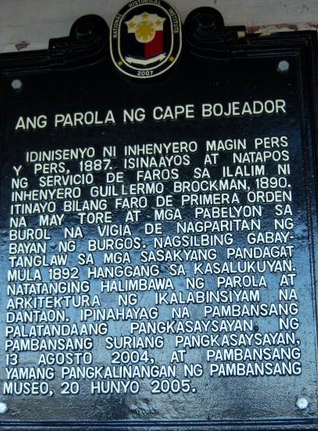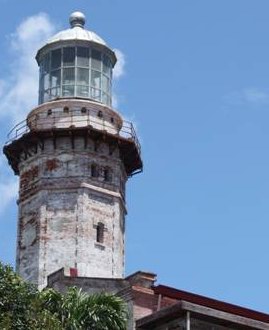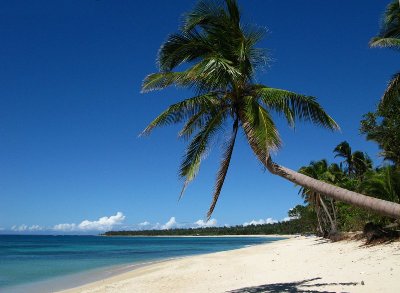Cape Bojeador Lighthouse
The historical Cape Bojeador Lighthouse is situated on a rocky promontory near the town of Burgos and it is also known as Faro Cabo Cape Bojeador.
The lighthouse is constructed on the hill named Vigia de Nagparitan overlooking the South China Sea and is the highest within the Philippines.
It is National Treasure heritage listed by the National Museum as one of the last Philippine Spanish Lighthouses.
The Cape Bojeador Lighthouse is also one of the most accessible of all the Luzon lighthouses and probably the most visited by tourists.
The light was constructed and completed on 30th March, 1892 and is still operational.
Cape Bojeador Lighthouse
As an ex-seafarer I recall sighting this light as we sailed down from Taiwan to Manila. These days even with GPS it is still a comforting sight.
The Cape Bojeador Lighthouse hill has an approximate height of around 160 meters high and the light tower height is around 17 meters.
The Cape Bojeador Lighthouse marks the treacherous bend that is the Northwestern corner of Luzon Island, separating it from the South China Sea and the Babuyanes Channel.
It also guides ships heading towards the ports of Salomangue in Ilocos Sur which lies 87 kilometres south from the Cape Bojeador Lighthouse , and Curmimao, which is 60 kilometres away in Ilocos Norte.
Cape Bojeador Lighthouse Details
The Cape Bojeador Lighthouse light flashes once every 60 seconds.
The Cape Bojeador Lighthouse now operates with new lenses powered by solar panels and the original light used pressurized kerosene lamps.
The Cape Bojeador Lighthouse pavilion is also now a mini-museum as well as offering lodging for people looking for very basic accommodation. There are no amenities available. The tower is accessible to visitors and the very friendly light keeper will assist if you want to climb the long and circular staircase and the steep, steel ladder to reach the beacon light area.
The design and construction of the Cape Bojeador Lighthouse was initially performed by the Engineer Magin Pers y Pers and was subsequently reconfigured and completed by Engineer Guillermo Brockman. The tower is constructed from locally made red bricks, and accented with cast iron grill work and the tower is octagonally-shaped with an inside dimension of two meters and an external dimension of three and half meters.
The structure is made of local red bricks and accented with cast iron grill work and stands 65 feet/20 meters high, considered the highest elevated lighthouse in the country. Cape Bojeador Lighthouse was declared a National Treasure by the National Museum.
The light mechanism comprised a winding mechanism consisting of a counter weight which when wound then made the lantern supporting the lenses to rotate. The housing of the counter weight is located in the centre of the spiral staircase which when wound drops all the way to the bottom of the stairs.
It takes approximately one hour for the weight to reach a full cycle, which would then enable the lantern to rotate. The job of the Cape Bojeador Lighthouse keeper was then to wind the mechanism to ensure the continuous rotation of the lens throughout the night. This practice was subsequently stopped when the tower suffered damages during the 1990 earthquake.

Cape Bojeador Lighthouse Access
There is a visible sign board at the right side of the highway indicating the entrance to the winding road leading to the base of Cape Bojeador Lighthouse. Access to the lighthouse is through a two-lane narrow concrete road that starts at the north side of the Maharlika highway. The road then winds and climbs up a steep hill.
On arrival visitors have to climb a flight of concrete stairs to the perimeter wall, which offers a panoramic view of the Cape Bojeador and the South China Sea
Advise the caretaker before entering the Cape Bojeador lighthouse. There is no parking or entrance fee however tipping the caretaker for his efforts would be appreciated. Enjoy Pagudpud.

